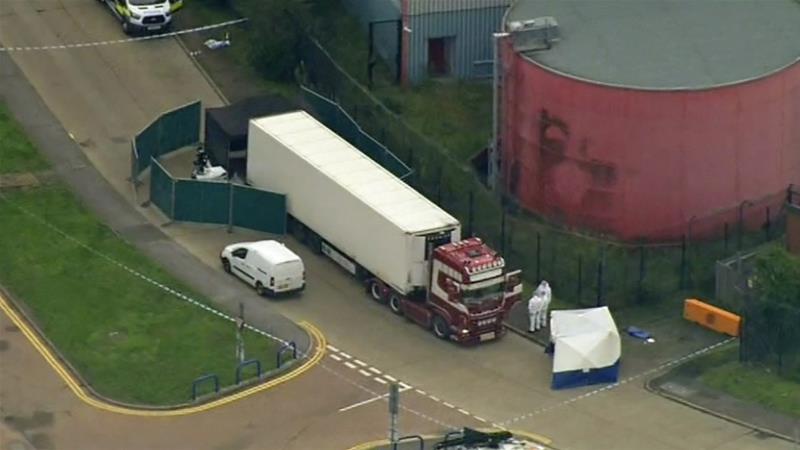Human Trafficking- A Present Day Slavery

In Grays, Essex a grisly discovery was made in the trailer of a truck. 39 bodies, 31 men and 8 woman, were found dead, killed by the freezing conditions they were put through. This hasn’t been the first time that such a tragedy involving trafficked migrants has happened, in 2004 twenty-one trafficked Chinese migrants drowned when the tide came in at Morecambe Bay, England while they were being forced to pick cockles on the beach. More recently in 2015 the bodies of over 71 people, all from the Middle East, were also discovered in a lorry in Burgenland, Austria. They had all suffocated.
Why would people risk their lives to sneak into western nations? There are many reasons someone might risk their lives to leave their country, the most common include not feeling safe at home due to crime or war, limited opportunities, lack of education, wanting to escape poverty, religious and/or ethnic persecution, homophobia, and wanting to support their family through remittances. Others, like many North Koreans travelling through China, are trying to escape their oppressive nation in the hopes of settling into a free one. A representative of APT (Act to Prevent Trafficking) Ireland, an organisation dedicated to spreading awareness and supporting the victims of human trafficking, Catherine Dunne, informed us “It’s the exploitation of vulnerable people. It entails control and power-wielding over people who are weak or vulnerable or open to being enticed to better situations. The background to that could be sheer poverty, where people see no future for themselves”.
People become so desperate to leave that there have been rare instances where they’ll even stowaway in a planes landing gear only to die from hypothermia, asphyxiation or fall to their death as seen with the recent case involving Kenya Airways.
The three most common types of human trafficking are sex trafficking, forced labour- for example, being forced to work as a labourer on a farm or a sweatshop, and debt bondage. If they survive their clandestine journey victims will likely be exploited through prostitution, forced labour, bonded labour (have to repay their traffickers a debt they’ll never be able to pay), begging, criminal activity, domestic servitude, forced marriage and organ removal. Victims will likely experience emotional trauma, mental and physical abuse, alcohol and/ or drug abuse, if their victims of sex trafficking than they might contract an STI such as HIV/AIDS, and sometimes might even suffer from Stockholm syndrome.
The International Labour Organization has estimated that over 21 million people are slaves, though some estimate it to be as high as 27 million. This is the highest amount in history which is ironic as every nation has banned slavery. 68% are forced into doing labour while 22% are exploited sexually. The International Labour Organisation also estimates that slavery is a $150 billion business and the average cost of a modern day slave is as low as US$90 while a slave in America during the 1800s cost around 400 times more at US$40,000.
According to Forbes, more than half of all slaves are enslaved within five countries- India, China, Pakistan, Uzbekistan and Bangladesh. North Korea has the highest prevalence of slavery with 4.4% of its population bound in enslavement, Uzbekistan is a close second at 4% and Cambodia is third at 1.6%. Russia, Belarus, Iran and Turkmenistan are considered among the worst in providing protection against human trafficking and forced labour. What’s even more tragic is that 1 in 4 modern slaves are children, around 1.2 million of them.
There have been efforts to curb human trafficking. According to Citizens Information, the Irish government passed the Criminal Law (Human Trafficking) Act 2008 and the Criminal Law (Human Trafficking) (Amendment) Act 2013 making it an offence to traffic people, child or adult, for use of sexual or labour exploitation, forced criminality, forced begging or removal of their organs as well as make it an offence to sell, purchase, offer to sell and purchase, anyone. The Criminal Law (Sexual Offences) Act 2017 made it criminal to purchase sexual services and the soliciting or purchasing of sex from a trafficked person.
According to the An Garda Siochana website, there are signs to look out for if you suspect someone is a victim of trafficking. These include them showing signs that their movement is controlled, having a false identity or travel documents, not knowing their home or work address, having no access to their earnings, are not able to negotiate working conditions, working excessively long hours over long periods, having limited social interaction and believing they are bonded by debt. There are several victim support organisations in Ireland that can help, these include state organisations such as The Human Trafficking Investigation and Coordination Unit of the An Garda Siochana, the Department of Justice and Equality and the Human Trafficking/ Administrative Support Unit by the Legal Aid Board. Non-governmental organisations include Migrant Rights Centre Ireland, the Immigrant Council of Ireland and Doras Luimni.
The tragedy in Essex reveals that human trafficking is not something that happens rarely and far between, “it is a reality at our doorstep, we can say now in every town and village in Ireland, we can see signs or traces there of incidences linked to human trafficking that need attention and we need to be alert to this” Ms Dunne told us. It shows us that this egregious abuse of human lives can happen in any city in any neighbourhood and it could happen without us realising it. Ms. Dunne informed us of how to tackle trafficking “we believe in education, by informing a class of schoolboys of how dangerous and involved in human trafficking the prostitution industry is, we can prevent this. We need to tackle the demand.” It will take much time and a lot of effort but, with awareness, vigilance and the refusal to forget past tragedies, we can stamp out this modern day slave trade.


